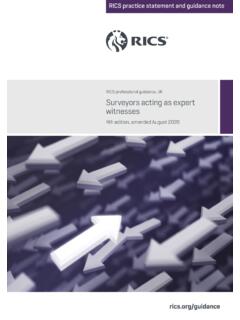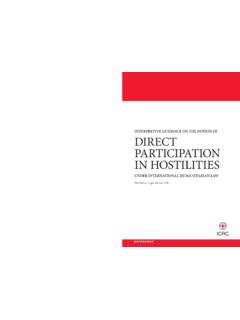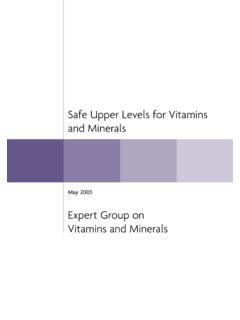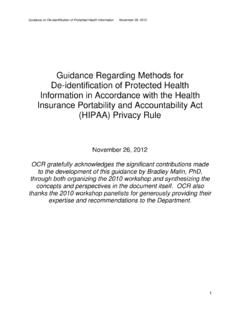Transcription of The Role of Information and Communication Technologies in ...
1 THE ROLE OF Information AND COMMUNICATIONTECHNOLOGIES IN AN INTEGRATED CAREERINFORMATION AND guidance SYSTEMDIAPSH6 UDPIBVD96I8@ WattsNational Institute for Careers Education and Counselling, United KingdomA paper prepared for an OECD review of policies for Information , guidance and counselling servicesCommissioned jointly by the European Commission and the OECDN ovember 20012 ABSTRACT ICT is used extensively in the delivery of career Information and guidance . Such usage covers awide range of applications. Key trends include its increased accessibility, its increased interactivity, and the more diffusedorigination of ICT-based resources.
2 The role of ICT in guidance can be seen in three ways: as a tool, as an alternative, or as an agentof change. The growth of websites and helplines as forms of technically mediated servicedelivery means that the potential of ICT as a change agent is now greater than ever before. The telephone, websites and e-mail, alongside face-to-face facilities, could be alternativeservices; or they could be portals into a wide, flexible and well-harmonised network of policy may support or impede such harmonisation.
3 The potential roles of public policy in relation to ICT-based guidance and Information provisioninclude funding such provision as part of their general funding for guidance and informationservices; or confining their role to funding areas of market failure and/or to quality and Communication Technologies are transforming career Information and guidanceservices, just as they are transforming service delivery in other sectors ( banking and health services).This poses major issues for policy-makers.
4 To what extent can investment in ICT enhance the cost-effectiveness of services? Should investment in ICT be viewed as an alternative to face-to-face services, oras a means of enhancing the quality of such services? What are the respective roles of government, ofcareer guidance professionals and of the private sector in promoting the application of ICT within thisfield?The present paper addresses these and related issues. It starts by examining the evolution of ICTand the ways in which it is currently being used in the delivery of career Information and guidanceservices.
5 It then looks at the types of clients with whom ICT-based systems are particularly used, and athow such systems can both expand and restrict access to career Information and guidance . It next exploresways in which ICT can complement and/or be integrated with other ways of providing career , it identifies a number of key policy issues relating to the role of ICT in national and regional careerinformation and guidance evolution of the application of ICT in the field of career Information and guidance can bedivided into four phases.
6 The first was the mainframe phase, from the mid-1960s to the late 1970s. Anumber of computer-aided guidance systems were developed which demonstrated the potential of the costs of direct interaction with the computer meant that the only systems which proved widelypracticable in cost terms were based on batch processing. The static nature of this process and thefeedback delays limited the implementation of such second was the microcomputer phase, from the early 1980s to the mid-1990s.
7 The advent ofthe microcomputer made interactive usage much more economical, and also made it easier to develop andmarket limited software packages; its attractiveness grew as more powerful versions of the personalcomputer were developed. The result was a substantial growth in the number of computer-aided guidancesystems, and in the extent of their usage. By the 1990s it was difficult to find a guidance service in anydeveloped country which did not make use of such third was the web phase, in the late 1990s.
8 The advent of the Internet meant that instead offree-standing systems located in career guidance centres, websites could be developed which individualscould access instantly from a wide variety of sites, including their homes. The ease of developing suchwebsites produced a massive increase in their number; the ease of interconnecting them meant that they no4longer needed to be viewed as discrete entities. Rather than perceiving ICT solely as a service fromexternal suppliers, guidance services began to develop their own fourth is the digital phase, which we are now entering.
9 The hitherto separate analoguestreams of the computer, the television and the telephone are merging into an integrated digital river (Cunningham & Fr schl, 1999). Individuals are now able to access the Internet not only through theirpersonal computers but also through their televisions and mobile phones. Greatly enhanced bandwidth willshortly enhance its speed and its capacity for transmitting video and audio as well as these four phases, three key trends can be discerned.
10 The first is increased initially ICT-based career guidance and Information services were available only at a selectnumber of technically-equipped service locations, they are now available not only in most guidanceservices but also in a vast range of other locations homes, workplaces, community locations. The secondis increased interactivity. In the early stages, resources were developed as separate systems, offering onlylimited interactivity with users. Now, they are highly interactive not only with users but also with eachother and across inter-media boundaries.















